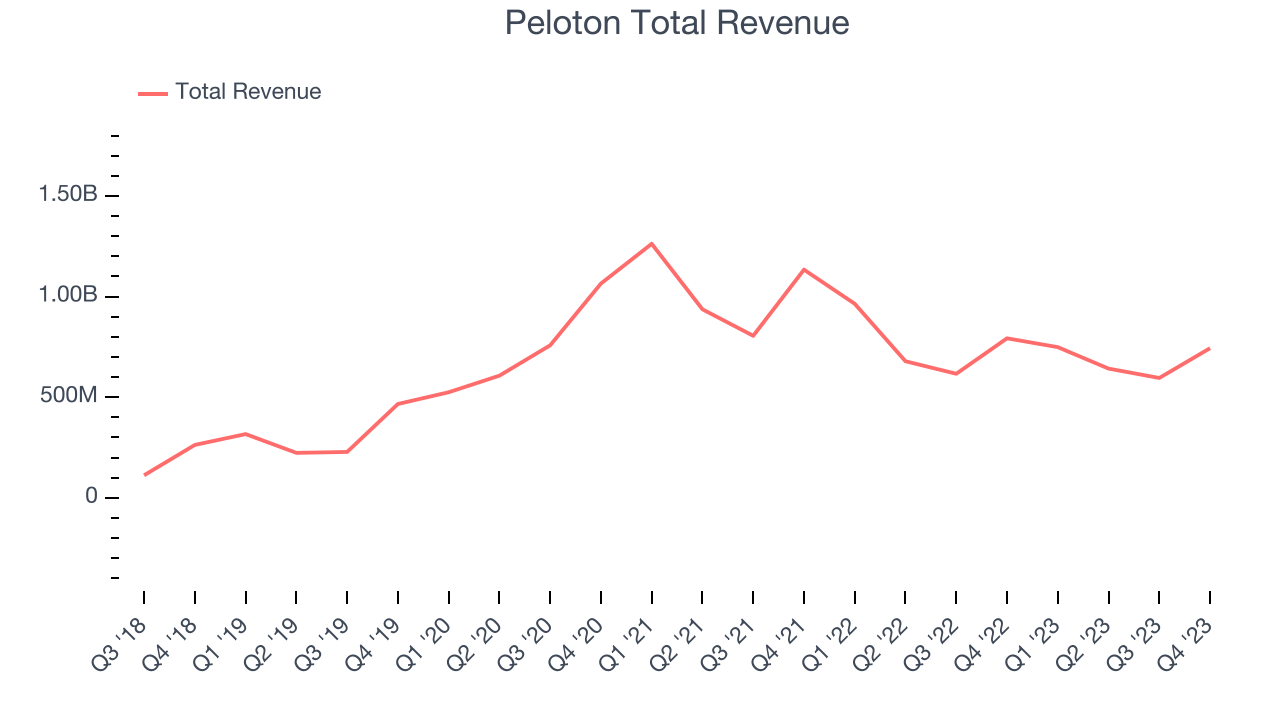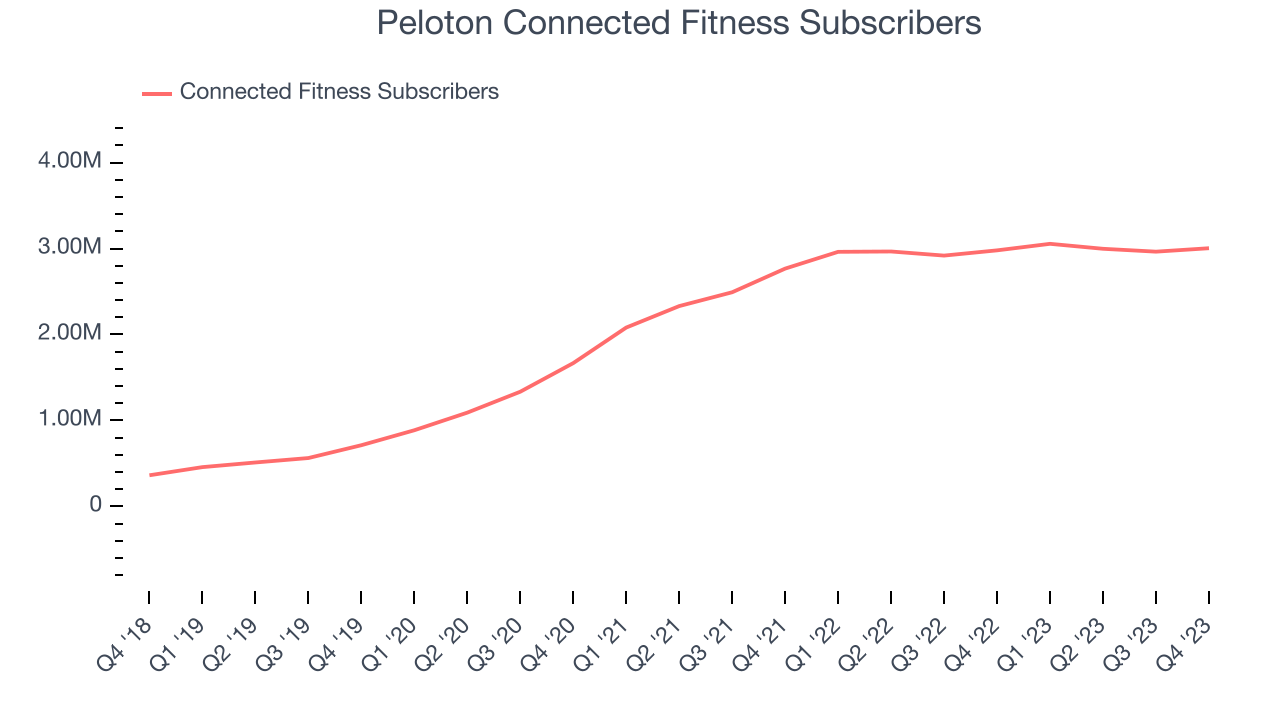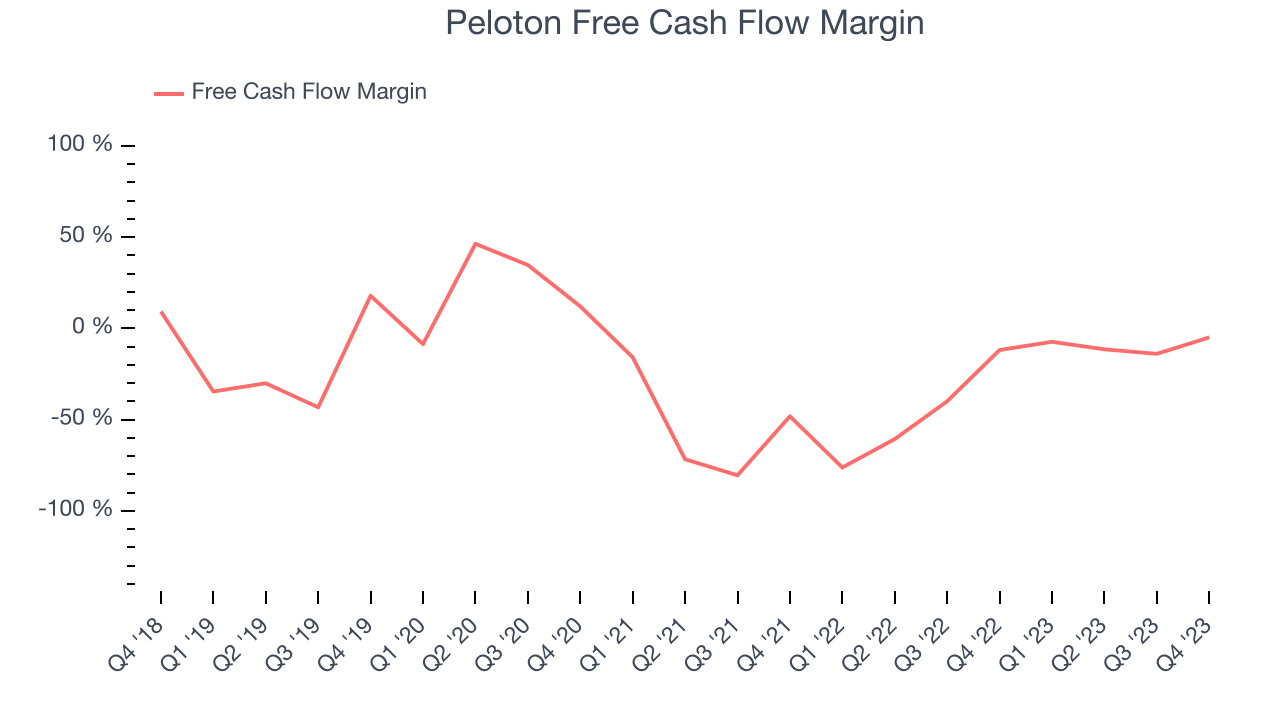Exercise equipment company Peloton (NASDAQ:PTON) beat analysts' expectations in Q2 FY2024, with revenue down 6.2% year on year to $743.6 million. On the other hand, next quarter's revenue guidance of $712.5 million was less impressive, coming in 5.5% below analysts' estimates. It made a GAAP loss of $0.54 per share, improving from its loss of $0.65 per share in the same quarter last year.
Is now the time to buy Peloton? Find out by accessing our full research report, it's free.
Peloton (PTON) Q2 FY2024 Highlights:
- Revenue: $743.6 million vs analyst estimates of $734.2 million (1.3% beat)
- EPS: -$0.54 vs analyst expectations of -$0.52 (3.6% miss)
- Revenue Guidance for Q3 2024 is $712.5 million at the midpoint, below analyst estimates of $753.8 million
- The company dropped its revenue guidance for the full year from $2.75 billion to $2.71 billion at the midpoint, a 1.4% decrease
- Free Cash Flow was -$37.2 million compared to -$83.3 million in the previous quarter
- Gross Margin (GAAP): 40.3%, up from 30.1% in the same quarter last year
- Connected Fitness Subscribers: 3 million
- Market Capitalization: $2.00 billion
Started as a Kickstarter campaign, Peloton (NASDAQ: PTON) is a fitness technology company known for its at-home exercise equipment and interactive online workout classes.
Leisure Facilities and Products
Consumers have lots of choices when it comes to how they spend their free time and extra money, so the companies offering leisure products and experiences must highlight their value proposition. Fitness companies may be riding the wellness trend, for example, while those selling recreational vehicles or toys may have to lean into innovation to stand out. Either way, all leisure companies must compete against the 800-pound gorilla of social media and streaming entertainment, which offer instant gratification and have been taking share of consumers’ free time for over a decade.
Sales Growth
A company’s long-term performance can give signals about its business quality. Even a bad business can shine for one or two quarters, but a top-tier one may grow for years. Peloton's annualized revenue growth rate of 34.3% over the last 5 years was incredible for a consumer discretionary business.

Within consumer discretionary, a long-term historical view may miss a company riding a successful new product or emerging trend. That's why we also follow short-term performance. Peloton's recent history shows a reversal from its 5-year trend, as its revenue has shown annualized declines of 18.8% over the last 2 years.
We can dig even further into the company's revenue dynamics by analyzing its number of connected fitness subscribers, which reached 3 million in the latest quarter. Over the last 2 years, Peloton's connected fitness subscribers averaged 12.6% year-on-year growth. Because this number is higher than its revenue growth during the same period, we can conclude the company's average price per sale has fallen.

This quarter, Peloton's revenue fell 6.2% year on year to $743.6 million but beat Wall Street's estimates by 1.3%. The company is guiding for a 4.8% year-on-year revenue decline next quarter to $712.5 million, an improvement from the 22.3% year-on-year decrease it recorded in the same quarter last year. Looking ahead, Wall Street expects sales to grow 4.6% over the next 12 months, an acceleration from this quarter.
It’s not often you find a high-quality company at a significant discount to its historical P/E multiple, but that’s exactly what we found. Click here for your FREE report on this attractive Network Effect stock at a very silly price.
Cash Is King
Although earnings are undoubtedly valuable for assessing company performance, we believe cash is king because you can't use accounting profits to pay the bills.
Over the last two years, Peloton's demanding reinvestments to stay relevant with consumers have drained company resources. Its free cash flow margin has been among the worst in the consumer discretionary sector, averaging negative 28.3%.

Peloton burned through $37.2 million of cash (negative 5% margin) in Q2, increasing its cash burn by 60.6% year on year.
Key Takeaways from Peloton's Q2 Results
It was encouraging to see Peloton narrowly top analysts' revenue expectations this quarter. That stood out as a positive in these results. On the other hand, its EPS missed analysts' expectations and its revenue guidance for next quarter missed Wall Street's estimates. Overall, this was a mixed quarter for Peloton. The stock is up 2.9% after reporting and currently trades at $5.73 per share.
Peloton may not have had the best quarter, but does that create an opportunity to invest right now? When making that decision, it's important to consider its valuation, business qualities, as well as what has happened in the latest quarter. We cover that in our actionable full research report which you can read here, it's free.
One way to find opportunities in the market is to watch for generational shifts in the economy. Almost every company is slowly finding itself becoming a technology company and facing cybersecurity risks and as a result, the demand for cloud-native cybersecurity is skyrocketing. This company is leading a massive technological shift in the industry and with revenue growth of 50% year on year and best-in-class SaaS metrics it should definitely be on your radar.
